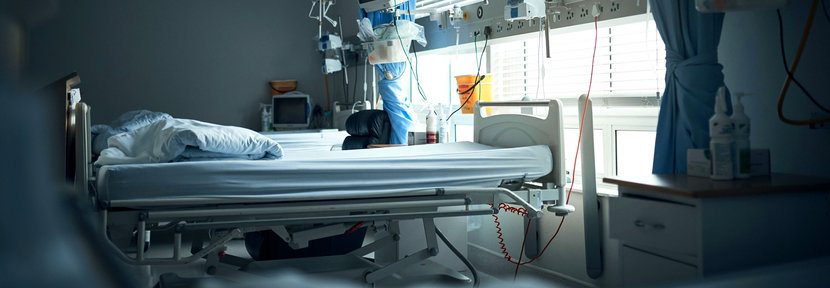4 minuti di lettura
19 novembre 2024
TENDENZE A LIVELLO DI TECNOLOGIA E MALATTIE
Prospettiva dell’esperto
Candida auris: minaccia crescente e implicazioni future
Candida auris come minaccia globale
I Centers for Disease Control and Prevention (CDC) statunitensi hanno etichettato la Candida auris come una “minaccia globale” e considera urgente il livello di minaccia.1C. auris, un patogeno fungino, è emerso come grave preoccupazione per la salute a causa del suo potenziale di causare infezioni invasive e aumentare la resistenza ai farmaci antimicotici. Scoperta per la prima volta nel 2009 in Giappone, la 2C. auris ha rapidamente attirato l’attenzione come potenziale causa di infezioni del flusso sanguigno gravi e potenzialmente letali e di epidemie in strutture sanitarie come ospedali e case di cura.3
Significato clinico di C. auris
C. auris colonizza la pelle e il naso di alcuni pazienti ricoverati senza causare malattie.4 La colonizzazione con C. auris può diffondersi nelle strutture sanitarie poiché viene trasferita su superfici su cui può persistere per giorni o settimane.3 La colonizzazione di un paziente può persistere per mesi, o anche a tempo indeterminato, 5con un’ampia opportunità di diffusione.
C. auris è un fungo particolarmente robusto e resiste agli agenti decolonizzanti e disinfettanti noti come efficaci contro altre specie di Candida. 3 Ciò rende particolarmente difficile la gestione delle epidemie.
Sono state osservate gravi malattie invasive nel 5-10% dei soggetti colonizzati.6 Queste infezioni presentano alti tassi di mortalità nei pazienti fragili in ospedale e in case di cura, dal 30% al 72%.3
Aumento dei casi durante la pandemia di COVID-19
La C. auris è stata identificata in Asia meridionale, Asia orientale, Africa, Sud America e Iran. Si è diffusa in tutti i continenti, ad eccezione dell’Antartide,3 con un aumento dei casi osservati durante la pandemia di COVID-19.7
La C. auris ha iniziato a diffondersi negli Stati Uniti nel 2015 e il numero di casi segnalati è aumentato del 318% 2018 rispetto alla media segnalata dal 2015 al 2017.1 Ciò ha fatto sì che le agenzie sanitarie pubbliche, gli addetti alla prevenzione, i ricercatori e i fornitori di diagnostica ne prendessero atto.

Uno degli aspetti più preoccupanti di C. auris è il suo elevato livello di resistenza ai farmaci antimicotici. Sono stati segnalati insuccessi del trattamento con alcuni farmaci antimicotici ed è stata osservata pan-resistenza a più classi di farmaci.1, 3
Nel suo Rapporto sulle minacce di resistenza agli antibiotici del 2019, il CDC osservava che i suoi esperti di patogeni fungini non avevano mai ricevuto un rapporto che descrivesse un’infezione da Candida resistente a tutti i farmaci antimicotici, tantomeno di una Candida che si diffondesse facilmente tra i pazienti.1
In risposta alla minaccia globale, il CDC ha attivato l’allarme negli Stati Uniti e ha etichettato C. auris come una delle 5 minacce antimicrobiche urgenti per la società.1
L'approvazione della rezafungina da parte della Food and Drug Administration statunitense nel 2023 fornisce una nuova e promettente opzione di trattamento per le infezioni da C. auris,8 ma un rilevamento rapido e accurato del fungo è essenziale per gestire questa minaccia.

Origine immagine: https://www.cdc.gov/antimicrobial-resistance/media/pdfs/2019-ar-threats-report-508.pdf?CDC_AAref_Val=https://www.cdc.gov/drugresistance/pdf/threats-report/2019-ar-threats-report-508.pdf
Rilevamento e identificazione di laboratorio
Lo screening dei pazienti per C. auris è una misura preventiva chiave contro i focolai epidemici nelle strutture sanitarie. Tuttavia, il rilevamento e l’identificazione accurati di C. auris possono essere difficili.
I sistemi di identificazione fenotipica possono essere imprecisi, con conseguente errata identificazione di C. auris .9 La coltura del fungo richiede specifiche condizioni di biosicurezza e vari giorni.
Il CDC raccomanda la spettrometria di massa e metodi molecolari come il sequenziamento e la PCR per rilevare e identificare accuratamente C. auris . Gli isolati possono anche essere inviati a laboratori di salute pubblica e di riferimento per l’identificazione. Anche se questi meccanismi forniranno risultati accurati, le strutture potrebbero non avere accesso a tecnologie come la spettrometria di massa e il sequenziamento. Il tempo di risposta per l'invio dei campioni per l'analisi può anche causare ritardi durante la finestra critica per rilevare la colonizzazione e prevenire la diffusione.
L’impatto dello screening PCR interno
L’implementazione di test PCR interni per lo screening di C. auris ha prodotto risultati positivi. Consente l’identificazione precoce dei/delle pazienti colonizzati/e e potenziali risparmi sui costi relativi all’isolamento e ai test.11 Questo approccio può essere più efficiente dell’invio dei campioni per i test, fornendo al contempo risultati affidabili.
La strada futura
Man mano che i casi di C. auris continuano ad aumentare e la resistenza antimicrobica diventa più prevalente, soluzioni di test più rapide e accurate saranno strumenti cruciali per rilevare i casi in anticipo e prevenire le epidemie.
Esistono alcuni test commerciali basati su PCR che rilevano C. auris.9Tuttavia, i test attuali sono progettati per essere eseguiti da professionisti qualificati in ambienti di laboratorio.
Tali test potrebbero non essere facilmente accessibili in contesti come le case di cura, dove possono risiedere i/le pazienti più suscettibili a gravi infezioni da C. auris.
Un test prototipo di sorveglianza rapido e on-demand per C. auris è stato progettato per fornire risultati accurati in meno di un'ora in contesti vicini al paziente.10
Il test prototipo è progettato per essere eseguito sul sistema GeneXpert® di Cepheid, che consente il test in laboratorio e presso il punto di cura. Tale test potrebbe portare a un rilevamento e a un intervento precoci in ambito sanitario, con un potenziale miglioramento dei risultati clinici, finanziari e operativi.
C. auris rappresenta una sfida significativa per i sistemi sanitari di tutto il mondo a causa del suo potenziale di causare infezioni invasive, alti tassi di mortalità e resistenza ai farmaci antimicotici. Vigilanza, formazione del personale, linee guida in evoluzione, sviluppo continuo di farmaci e metodi di disinfezione e soluzioni di test innovative sono fondamentali per affrontare questa minaccia emergente.
Riferimenti bibliografici:
1. Centers for Disease Control and Prevention (CDC). Antibiotic resistance threats in the United States, 2019. Atlanta, Georgia: National Center for Emerging Zoonotic and Infectious Diseases (U.S.); 2019 Nov.
2. Satoh K, Makimura K, Hasumi Y, Nishiyama Y, Uchida K, Yamaguchi H. Candida auris sp. nov., a novel ascomycetous yeast isolated from the external ear canal of an inpatient in a Japanese hospital. Microbiol Immunol. 2009 Jan;53(1):41–4.
3. Sikora A, Hashmi MF, Zahra F. Candida auris. StatPearls. Treasure Island (FL): StatPearls Publishing; 2024.
4. About C. auris [Internet]. CDC: Candida auris (C. auris). [citato il 2024 lug 2]. Disponibile su: https://www.cdc.gov/candida-auris/about/index.html
5. Biswal M, Rudramurthy SM, Jain N, Shamanth AS, Sharma D, Jain K, et al. Controlling a possible outbreak of Candida auris infection: lessons learnt from multiple interventions. J Hosp Infect. 2017 Dec;97(4):363–70.
6. Sansom SE, Gussin GM, Schoeny M, Singh RD, Adil H, Bell P, et al. Rapid Environmental Contamination With Candida auris and Multidrug-Resistant Bacterial Pathogens Near Colonized Patients. Clin Infect Dis. 2024 mag 15;78(5):1276–84.
7. Pandak N, Al Sidairi H, Al-Zakwani I, Al Balushi Z, Chhetri S, Ba’Omar M, et al. The Outcome of Antibiotic Overuse before and during the COVID-19 Pandemic in a Tertiary Care Hospital in Oman. Antibiotics (Basel). 2023 nov 27;12(12).
8. Syed YY. Rezafungin: First Approval. Drugs. 2023 Jun;83(9):833–40.
9. Identification of C. auris | Candida auris (C. auris) | CDC [Internet]. [citato il 2024 giu 2]. Disponibile su: https://www.cdc.gov/candida-auris/hcp/laboratories/identification-of-c-auris.html
10. Rossana Rosa, Adriana Jimenez, David Andrews, Huy Dinh, Katiuska Parra, Octavio Martinez, Lilian M Abbo, Impact of In-house Candida auris Polymerase Chain Reaction Screening on Admission on the Incidence Rates of Surveillance and Blood Cultures With C. auris and Associated Cost Savings, Open Forum Infectious Diseases, Volume 10, Issue 11, November 2023, ofad567, https://doi.org/10:1093/ofid/ofad567
11. Banik S, Ozay B, Trejo M, Zhu Y, Kanna C, Santellan C, et al. A simple and sensitive test for Candida auris colonization, surveillance, and infection control suitable for near patient use. J Clin Microbiol. 2024 Jun 18;e0052524.
Leggi successivo
MOLTO PIÙ








